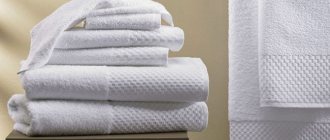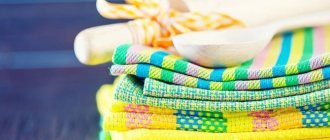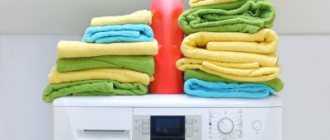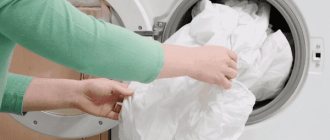Soft, beautiful and high-quality towels will make daily hygiene procedures even more enjoyable. Some people use 1-2 towels, washing them periodically. In fact, there should be much more of them, because it is not advisable to wipe your face with the same towel that you regularly dry your hands with. A towel is an individual item and it is important that it is not used by other people who may be carriers of diseases and bacteria. And just like a toothbrush, bath accessories need to be changed periodically. Below we tell you how often you need to change towels!
How often should bed linen be changed?
It is advisable to change bed linen once a week, especially in summer and spring. In winter, bed linen can be changed once every two weeks. More attention should be paid to pillowcases.
Interesting materials:
What is the best way to store jewelry? What is the best way to store nuts? What is the danger of depleting the ozone layer? What is the difference between borscht and cabbage soup? What is the difference between a clinic and a hospital? What is the difference between semolina and flour? What is the difference between marginality and profitability? What is the difference between a wish and a dream? What is the difference between general and professional competencies? What are the advantages of glo?
How many towels should you have in your home?
Towels are something you can never have too many of. Considering that they need to be washed and renewed frequently, it is advisable that you have a supply of towels. We also recommend purchasing several towels of different sizes for guests.
To maintain personal hygiene you will need towels:
- For the face - small towels that are convenient for wiping your neck and face while washing. It is undesirable to use them for other purposes, since bacteria and pathogens may appear on the fabric of the towel, causing various rashes.
- For hands - small towels that can be placed not only in the bathroom, but also in the kitchen. They are also convenient to take with you on a trip.
- For feet – products intended for wiping feet. Do not under any circumstances wipe your hands, face, or body with such towels.
- For intimate hygiene, designed to care for delicate areas.
- For the body - large fluffy towels in which you can completely wrap yourself and completely dry yourself after a shower or bath.
How often should you change kitchen towels?
Scientists have discovered an unpleasant truth about things that are familiar to us, but there is no need to get upset and panic. Yes, towels can be a real breeding ground for infection, but you can ensure that you can use them without fear. These methods are simple and we can all do them.
You just need to follow simple rules and get into the habit of paying special attention to kitchen textiles. It is worth listening to tips on how often to change kitchen towels:
- Towels in the kitchen and bathrooms should be changed every day. This is essential if you want to protect yourself from foodborne pathogens and other bacteria. For example, you need to change towels every time you dry dishes and wipe down surfaces after dinner.
- Do not throw wet towels into the basket with dirty clothes. Let them dry first, and then you can put them in the basket, or directly into the machine and wash them at the highest temperature.
- You cannot wash kitchen towels with clothes - this is a guaranteed way to “colonize” them with unnecessary bacteria.
What can result from untimely replacement of textiles?
Dirty laundry is not only a lack of comfort in the home, but also a risk of harming your health. Particular attention should be paid to replacing sheets and pillowcases; they are most susceptible to contamination due to close contact with the human body. They retain dead skin particles, sebum and sweat. If there are animals in the house, then fur and scales of animal epithelium are added to all these contaminants.
All this contributes to the proliferation of dust mites. It is impossible to see it with the naked eye, but the consequences in the form of allergic rashes and dermatitis can appear quite quickly. A dirty bed increases the risk of developing respiratory diseases. The accumulated dust and microscopic debris enters the respiratory tract, which can even lead to the development of asthma.
The cleanliness of towels also needs to be constantly monitored, as well as the condition of the bathroom. There is a high level of humidity in the bath and not everyone sends their towels out to dry after taking a shower. Because of this, after just one use they may develop an unpleasant odor. It will only get worse - bacteria will begin to multiply, which can cause mold to appear. The longer linen and towels are used, the more difficult it is to wash them. Pollution eats in more and more every day, this is especially noticeable on light-colored fabrics. Due to irregular washing, textiles quickly lose their original appearance and become unusable.
Washing Tips
The washing mode must be selected based on the manufacturer’s recommendations indicated on the label of the textile product, or based on the composition.
We recommend: Why you shouldn’t wash your jeans often?
The optimal temperature when washing towels is 40–50 degrees. This heating of water is quite enough to kill bacteria and germs. If there are stubborn stains, you can increase the temperature to 70 degrees.
Do not forget that not only the service life and appearance of the product, but also the health of your family members depends on a competent approach to the issue of washing towels.
Ironing - pros and cons
How many copies have been broken in the debate about whether to iron towels or not, but there is still no consensus.
The terry pile of towels gets crushed when ironed and they become hard. The fabric loses its hygroscopicity, it absorbs moisture much worse. Terry towels need to be hung carefully after washing and folded just as carefully after drying . An exception can be made when ironing terry towels for young infants. Here, ironing disinfects the fabric, killing any possible bacteria on the linen.
Linen and cotton kitchen towels are ironed right side out. Embroidered kitchen utensils are steamed or ironed from the inside out.
Thin microfiber cannot be ironed , as synthetic fibers are destroyed by the action of a hot iron.
You will find maximum useful information about washing clothes and various fabric products here.
How many times a day should you change your underwear?
Over time, germs and bacteria accumulate in the tissue and can cause fungal infections upon contact with the skin and mucous membranes. Therefore, doctors recommend updating your underwear at least once a year or even every six months.
Interesting materials:
How many times should I feed my Toy Terrier? How many times should Vietnamese piglets be fed? How many times should you feed a rabbit? How many times should laying hens be fed? How many times should baby rabbits be fed? How many times should laying hens be fed? How many times should chickens be fed? How many times should baby rabbits be fed? How many times should you feed your guinea pig? How many times a day should broilers be fed?
Latest Research
The object of research was one hundred kitchen towels. They were in use for a whole month, then bacteriological studies were carried out on them to discover what microorganisms inhabited this piece of kitchen textile. After such active use, many pathogenic microorganisms settled on the towels, but their number was influenced by several factors:
- number of family members who used towels;
- the type of diet that users followed;
- what functions were the towels used for?
The results of the study are impressive: almost half of the subjects studied showed the growth of harmful bacteria. Of the 49%, 36.7% had enterococci, 36.7% coliform bacteria, and 14.3% had Staphylococcus aureus on them. It is worth noting that the latter two types of bacteria were largely represented in areas where a vegetarian diet was not followed.
The number of bacteria was especially huge in large families with many children. In small families, towels were “safer.” Another fact is that there were more microorganisms on those towels that were used for a variety of purposes:
- wiped hands and dishes;
- used as oven mitts to remove hot baking sheets from the oven;
- wiped surfaces.
Towels that were used only for their intended purpose - to dry hands, dry vegetables - did not become such a desirable haven for dangerous bacteria. Scientists also found that far fewer organisms live on dry textiles than on wet textiles.
- Fine for cleaning windows on upper floors
- Tracking programs for Android - how to select, download and install on your phone with detailed instructions
- 5 things women should stop doing after 60
It is important to be responsible about the cleanliness and use of kitchen towels. Wet has no place in the kitchen. Also, do not use one towel for many different purposes. Particular attention to hygiene in the kitchen should be paid to those families where there are many children and elderly people.
What has an expiration date?
Expiration dates
installed on food products, perfumery and cosmetic products, medicines, household chemicals and similar products (work results), which after a certain time may pose a danger to the life and health of the consumer, cause harm to their property or the environment, or...
Interesting materials:
How to prune lilacs for lush flowering? How to trim lilacs for a bouquet? How to prune lilacs on a trunk? How to prune lilacs for the winter? How to prune Palibin lilac? How to prune a plum tree so it doesn't grow upward? How to prune a plum and when? How to prune a plum tree in the third year? How to prune a plum in spring and when? How to trim currants?
Why do towels need to be washed?
In the bathroom, with a towel we mainly remove excess moisture from the surface of our (or not our) body. ... And you can fight all these “living creatures” only by timely, regular and proper washing of towels.
Interesting materials:
How to pump your abs correctly and safely? How to pump up your abs correctly and quickly? How to stand in the plank correctly and for a long time? How to stand on the plank correctly and for a long time? How to look for truffles in Russia? How to use Calgon correctly? How to use film wax correctly? How to correctly measure the length of a curtain? How to correctly measure butt volume? How to correctly measure a woman's body parameters?
How to make fabric soft?
Reasons for deterioration in the quality of towels:
- hardness of water;
- use of low-quality washing powders;
- incorrectly selected washing mode - high temperature, insufficient rinsing, intensive spin;
- boiling towels, ironing instead of steaming.
How to ensure that soft and fluffy towels never become hard:
- Wash with liquid detergents without chlorine and phosphates.
- Use the quick wash mode more often for minimal impact on the fabric.
- Use an extra rinse.
- Bleaching terry cloth is absolutely necessary.
- Soften hard water.
And now more about each criterion
To eliminate the possibility of unwanted residents appearing in your bed and to protect your loved ones from health problems, you should listen to the recommendations
Age
In each age category, physical indicators are different. As the body grows, the secretions of various secretions undergo changes accordingly. This, in turn, affects the intensity of bed contamination. Age is one of the important indicators, let’s start analyzing it.
- Kids
We include newborns, infants, and children under 3 years old in this category. Their activity at night is quite high, which necessitates the need to remake the bed more often.
Answers to frequently asked questions
There are several questions regarding washing, the answers to which even experienced housewives often seek; experts have tried to give detailed answers to them:
- Why do towels become stiff over time? There are several main reasons for this problem, for example, washing in water of high hardness. This result can also be caused by using low-quality powder, washing at very high temperatures, bleaching with chlorine, poor rinsing of items, spinning at high speeds, and frequent ironing.
- How to soften fabric? You can reduce the water hardness by adding vinegar to it, use a quick wash mode, spin clothes at a speed of 400 rpm, use double or triple rinses. And also choose an environmentally friendly laundry detergent that does not contain chlorine or phosphates. It is desirable that it be liquid, since the powder is very difficult to dissolve and rinse out. You can soften terry towels by placing special balls in the washing machine drum.
- Is it possible to get rid of the unpleasant odor from towels? If items have been used for a long time or are constantly damp or left in the dirty laundry basket for a long time, they can actually begin to emit an unpleasant odor. If regular washing does not help get rid of it, try boiling them with laundry soap, then rinsing them in water with essential oil. Or soak for 8-10 hours in water with the addition of soda and vinegar, then wash as usual. If this does not help, you can use a special washing liquid that effectively removes unpleasant odors, for example, OXICLEAN Freshness.
- Does bleaching harm fabrics? Bleaching does not harm the fibers if a chlorine-free product is used. The desired effect can be achieved by using a solution made from 5 liters of water, 1 tablespoon of ammonia and 25 ml. hydrogen peroxide. Products need to be soaked in the solution for 30 minutes and then washed. Or you can soak things in ice water to which salt has been added (2 tablespoons per 1 liter of water). You can also buy commercial chlorine-free bleach.
And the last question on which opinions differ: should towels be ironed? Our experts believe that products used to wipe the body, hands, and face do not need to be ironed. Otherwise, they become hard, lose their hygroscopicity, that is, they absorb water worse. To make the product look neat and not wrinkle, just shake it after washing and straighten it with your hands on a rope or dryer bar. But towels used in the kitchen can be ironed, since additional disinfection would not interfere with them, and besides, the housewives try not to put wrinkled things on public display.
Rules for caring for kitchen towels
Basic recommendations for the use and care of kitchen towels:
- Always change kitchen towels if they have been used to wipe down dishes or surfaces that have come into contact with raw meat.
- When washing towels, choose the longest wash cycle at the highest temperature. It is hot water that allows you to better wash out dirt from the fabric, and thus remove microorganisms.
- Do not use fabric softener when washing kitchen towels. It creates an invisible film on the surface of the fabric; contact with food should be avoided.
- Rinse the fabric thoroughly. Cleaning agents may not be easily rinsed out of the fibers. Don't be lazy, turn on an additional rinse cycle.
- Make sure your towels are dry before throwing them into the laundry basket. Warm, dark, damp environments are a haven for harmful microorganisms. In such conditions, the towel will smell musty, and mold may even appear on it. The best option is to let the towel dry overnight and put it in the wash in the morning.
- The more of these kitchen accessories you have, the more often you can afford to replace them. So take a look at your kitchen towels and add new items to your collection.
Factors influencing the frequency of linen changes
The service life of a bedding set depends on several indicators. We list the factors by which you can determine the time to change your pillowcase, sheets and duvet cover.
Age
- Newborn babies should change diapers every day or more often as they get dirty.
- Since the immunity of a small child is not yet strong, the body cannot resist negative influences from the outside. To keep your baby as safe as possible, you need to change the sheets and duvet cover every 2-3 days, and pillowcases every day. If you have the ability to replace more often, that will be a plus.
- Children from 4 to 12 years old need to change their bed linen every 7-10 days, as they sweat less than adults. Pillowcases should be washed after 1-2 days. In kindergartens, according to sanitary standards, linen is changed three times a month, that is, every 10 days.
- Teenagers need to change the set after 4-5 days, since when hormonal levels change, they begin to sweat more, therefore, the bed gets dirty faster. If a child of adolescence has acne, it is necessary to wash the pillowcases every day.
- Adults can change their bedding, including pillow covers, every 5-7 days.
Important! If you have furry animals that like to sleep in the bed with you or your children, you should change the bed more often. If it is not possible to wash it, remove any hair that has accumulated from your pet using a clothes cleaning roller.
Health status
Another factor that needs to be taken into account when changing bed linen is the presence of diseases. During illness, bacteria multiply faster and remain on the sleeping set. Therefore, to prevent re-infection, it is necessary to change the bed linen daily. If the illness is not serious, for example, a common cold, the bed should be remade every 3-4 days. If you have allergies, change your linen every 2-3 days, and change your pillowcase every day.
Season
At first glance, the time of year has nothing to do with how often you need to change your bedding set. However, it is not. The higher the temperature outside, the more a person sweats when sleeping. In addition, in the warm season, people, like all living organisms, are more active. All this is reflected in the cleanliness of the linen. Therefore, in summer, late spring and early autumn, it is recommended to change the bed twice as often as at other times, and be sure to change the pillowcase daily.
Attention! Every 5 years you need to buy new pillows and blankets, as the old ones become unusable. But they should be washed once a year. The lifespan of the mattress is 20 years, unless the instructions indicate a different time period.
What else is important to know about hygiene in the bedroom?
In addition to regularly washing bed linen, it is important to remember to keep other bedding items clean. To prevent the mattress from getting dirty so quickly, it is more convenient to use a mattress cover that can be easily washed in a washing machine. You can clean the mattress itself using a vacuum cleaner or a mild soap solution. When choosing wet cleaning, it is important not to make the bed immediately, but to let it dry completely.
If you use pillows and duvets made from delicate fillings such as silk, goose down or cashmere, you will need dry cleaning services. Many wool fillings, bamboo, eucalyptus and synthetic materials are machine washable. Follow the directions on the label, because it is important to wash blankets and pillows at a certain temperature so as not to spoil the filling. After washing, do not hang them on the dryer, but lay them out on a flat horizontal surface. This way the filler will not clump together and will dry faster. For convenience, we suggest you save the table and use it if necessary:
| Item for sleeping | Frequency of cleaning/washing |
| Bed sheets | once every 2 weeks |
| Mattress cover | once every 1-2 months |
| Pillows | once every 3-4 months |
| Blankets | once every 3-4 months |
| Mattress | at least 2 times a year |
Whitening - gentle and effective
Typically, bleaching is carried out during the washing process, when bleach is loaded into a special section of the machine. If hand washing is planned, the product is used in accordance with the instructions.
optical (Belofor, Persol, Dimerax) – whitening occurs due to the sedimentation of microparticles of the product on the fabric fibers;- oxygen (Swan, White without chlorine, Tadox, Vanish) - do not damage fabric, are effective when bleaching in slightly warm or cool water;
- chlorine-containing (Chlorin, Domestos, Belizna, AC) - used for bleaching cotton or linen towels.
One of the most effective methods of whitening towels is to soak them in a solution of 72% laundry soap. It needs to be rubbed and filled with hot water until it dissolves and produces foam.
Products made from terry cloth, linen, and cotton are kept in this solution for about an hour. Next comes hand or machine wash and rinse. The above method not only whitens, but also softens towels.
Another affordable and cheap whitening product is hydrogen peroxide. Sequence of use:
- Dissolve 2 tablespoons of peroxide in 5 liters of water.
- Place the towels in the solution for 40-50 minutes, stirring them from time to time.
- Rinse the items and hang them to dry.
Kitchen towel: what is the danger?
A towel is an indispensable accessory in any household. It is used to dry hands, polish plates and other cutlery to a shine, and remove unsightly water stains from them. It is used to dry washed fruits and vegetables, and sometimes to brush crumbs off the table with it, and then, with a clear conscience, hang it on the stove handle or a hook on the wall so that the fabric dries.
- 10 ways to relieve knee pain without drugs
- American Akita
- What you need to know about car towing
Factors to consider when purchasing towels
Photo by Pixabay
Here we will provide the most useful tips that housewives may need when buying high-quality and comfortable towels.
- A good towel is made from cotton thread or linen, cotton fabric. Today you can find towels made from microfiber - they are soft, absorb moisture well, very beautiful and light, but not as durable as towels made from natural materials. Cotton fiber from Egypt has received worldwide recognition - towels made from it are the best.
- Do not buy towels made from mixed fabrics containing up to 50% synthetic fiber. These towels are very pleasant to the touch, beautiful and bright, hold their shape well, are lightweight, and dry quickly. But when wiped, they do not absorb moisture well and “creak” across the body, leaving an unpleasant sensation. In addition, such low quality towels can shed a lot.
- If you are buying towels for travel, opt not for terry towels, but for waffle towels. These towels are much lighter and smaller in volume, but they wipe away moisture very well and are also easy to wash.
- The quality of terry towels (terry sheets and terry robes) is assessed by their density. Towels with a density below 320 g per m2 do not absorb as much moisture as those with a higher density; they quickly become wet, lose their shape, fade, and wear out. If you are buying towels for a bath or shower, bath or sauna, choose samples with a density of at least 470 g per m2. Thicker towels are even stronger, but they are more difficult to wash and dry.
- The pile of terry towels (as well as terry robes) can also vary in height. Too short a towel pile, from 3.5 mm, makes this product quite hard over time, it wears out faster. The very long pile of a terry towel - from 7-8 mm or more, tangles the hair, is pulled out in loops, clings to everything, and accordingly - quickly loses its fluffy beautiful appearance. The most optimal length of terry towel pile is from 4 mm to 5 mm.
- For use in the kitchen, it is better to buy waffle or linen towels rather than terry towels - they are easier to wash and dry faster, they are easy to iron, they retain their appearance longer, absorb moisture well, and wipe dishes without leaving lint on them.
- When purchasing, look carefully at the product labeling. If it says “cotton 100% (M)”, then this is a product with the inclusion of synthetic fibers in cotton. If the marking indicates (PC), the product contains polyestercotton artificial fiber.
- When purchasing, carefully inspect the product - it should be evenly colored, on both sides, and have a silky surface. Pay attention to the smell of the product - normally, a high-quality towel should not smell of chemicals.
- After running your hand over the surface of the product, look at your palm to see if it has become stained with the dyes included in the towel. If the seller allows, it is best to run a white napkin over the surface of the towel - the poor-quality color will be “obvious” immediately.
- If you see soybean fiber (“SPF”, soybean protein fiber) in the towel, then you can safely purchase this product. This type of fiber was developed in South Korea, it contains a substance resulting from the processing of soybean proteins. This fiber dries faster than cotton, and it absorbs moisture much better. Products made from soy fiber cannot be confused with any others - they are very soft, pleasant to the touch, similar to cashmere or silk. Such products must be washed at a temperature no higher than 60 degrees, and then they do not lose their shape and their wonderful properties for a very long time. Soy fiber is a means of preventing inflammation on the skin and aging of the skin.
- Currently, terry products are popular, which contain special fibers - lyocell (Lenzing Lyocell Micro). This fiber is made from eucalyptus wood, it absorbs moisture better, dries much faster than cotton, does not acquire any odors, and does not “absorb” dust particles. Towels with lyocell fiber are very soft to the touch, reminiscent of silk fabric. These towels are washed at a temperature not exceeding 60°C.
If you change it rarely
Sleeping on dirty sheets is fraught with many negative consequences.
Changing pillowcases and duvet covers is a hassle: you need to take off the old set, wash, iron, and then put on a new one. This takes a lot of time, so many people prefer to postpone this procedure “for one more week,” and then for another 1, and so on. Unfortunately, sleeping on a dirty bed can have a number of negative consequences. If you rarely change it, prepare for:
- Increased risk of developing allergies. A dirty bed contains many dust mites. In the spring and summer, allergens also settle on the bed: pollen, plant particles. A stuffy nose, watery eyes, and itching will have a bad effect on the quality of your rest.
- Deterioration of skin and hair condition. During sleep, the skin is constantly in contact with the fabric. If it is dirty, it will have a bad effect on the condition of the skin: acne, rashes, inflammation will appear on it, and the skin will become oily. This is especially true for those who have problem skin.
- Increased risk of respiratory diseases and infections.











